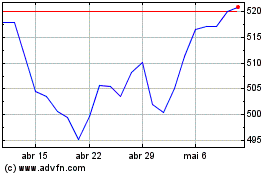Will a Santa Claus Rally Boost the S&P 500 This Week?
27 Dezembro 2022 - 8:17AM
Finscreener.org
In the last weekU+02019s trading
session, which ended on December 23, 2022, the U.S. equity markets
edged higher as consumer inflation decelerated in the past month.
Market participants now expect price pressures to moderate in the
next few months, which might also result in lower interest rates in
2023.
In the last five trading
sessions, the
Dow Jones index rose by
1.9, while the
S&P 500 and
Nasdaq indices fell by 0.2% and 0.9%, respectively, as
recession fears loomed large on the markets.
The upcoming week will be a short
one as the markets are closed on Monday. Will a holiday-fueled
Santa Claus rally drive the stock market, allowing
investors to offset a portion of these losses?
Let’s see what investors can
expect from the markets as we head toward the end of
2022.
Home prices data
The data for home prices in the
U.S. will be published in the next week. The S&P 500 Global
will release the Case-Shiller National Home Price Index for
November on Tuesday, while mortgage originator Freddie Mac will
disclose the Home Price Index data for the last month.
In October, the Case-Shiller
index suggested home prices fell 1.2% in October after a 1.5%
decline in September. It was the fourth consecutive
month-over-month price decline.
Home prices rose 9.1% year over
year in October, which was lower than the 10.4% year-over-year gain
in September. It was the slowest pace of annual price gains in over
two years, suggests a report from Investopedia.
Later this week, the NAR of the
National Association of Realtors will release data on pending home
sales for November. According to analysts, pending home sales will
slump 0.5% in November and 30% from the year-ago period. Pending
home sales are down in 11 of the past 12 months due to rising
mortgage rates, lower inventory, and a decline in
affordability.
Purchasing managerU+02019s index data remains
key
A key driver of the stock market
in the next week is the Purchasing Managers Index data that will
release on Friday by the Institute for Supply Management. The PMI
tracks manufacturing activity across the midwestern region in the
United States.
PMI in Chicago is likely to fall
after it touched 37.2 points in November compared to 45.2 points in
October. The PMI reading for October was the lowest in more than
two years when the onset of the COVID-19 pandemic resulted in
lockdowns and a slowdown in economic activity. Typically, a PMI
reading of less than 50 suggests a contraction in business
activity.
What next for the S&P 500?
The S&P 500 index entered
the bear market territory in September 2022 and is currently down
19.8% year-to-date. There is a small chance of the index gaining
momentum from a Santa Claus Rally due to investor optimism just
after Christmas.
The markets are moving lower in
December, but the current month has historically been among the
most-strongest months for equity investors. Since 1950, the
S&P 500 index has moved up by an average of 1% in December.
Further, in the last five trading days of December and in the first
two trading days of January, the index has gained 1.3% on average
in this period.
An Investopedia report states,
“There is no definitive explanation for why stocks tend to rise at
the end of the year, but some theories posit that holiday shopping,
seasonal optimism, and institutional investors settling their books
could have helped fuel the trend.”
SPDR S&P 500 (AMEX:SPY)
Gráfico Histórico do Ativo
De Mar 2024 até Abr 2024

SPDR S&P 500 (AMEX:SPY)
Gráfico Histórico do Ativo
De Abr 2023 até Abr 2024
